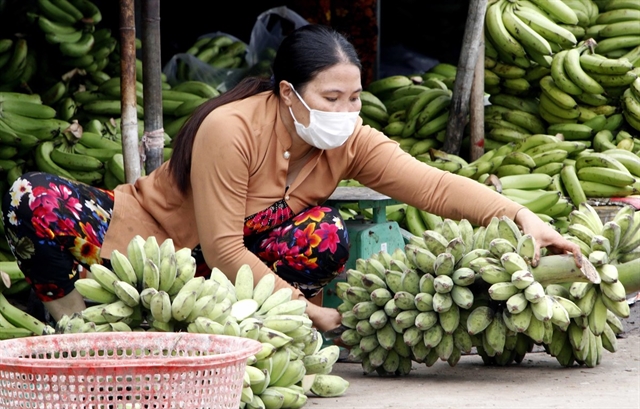 Society
Society


|
| Bananas sold in Cà Mau City’s Ward 7 Market. – VNA/VNS Photo Kim Há |
CÀ MAU – The southernmost province of Cà Mau plans to expand its area under banana to 6,000ha and annual output to 120,000 tonnes by 2025.
To increase the value and yield of its bananas, the provincial Department of Agriculture and Rural Development will popularise Vietnamese good agricultural practices (VietGAP) and organic standards.
Banana farmers will use intensive farming to increase yields, tissue culture and high-quality varieties.
The province will combine the banana orchards with eco-tourism services to add to farmers’ incomes.
It will encourage farmers to turn mixed orchards, areas around fields growing other crops and near forests and unproductive rice fields into banana plantations.
In the plantations, farmers will be encouraged to breed fish and livestock.
The province will strive to strengthen linkages between farmers and processors to increase the output of various products made from the fruit and its by-products.
Cà Mau, one of the largest banana growing provinces in the Cửu Long (Mekong) Delta, has 5,400ha under various varieties of the fruit, including 4,800ha of xiêm, with an annual output of 60,000 tonnes.
Nguyễn Trần Thức, head of the department’s Plant Protection and Cultivation Sub-department, said demand for xiêm bananas remains steady despite the COVID-19 pandemic, and it fetches farmers a price of VNĐ3,500 a kilogramme, the same as before the outbreak.
The province’s bananas are sold in the delta and HCM City and exported to Cambodia through local traders.
Most are sold for eating fresh, with a quantity meant for processing into products like dried banana and banana cake.
The banana growing areas are located mostly in U Minh and Trần Văn Thời districts.
U Minh has identified xiêm banana as one of its four key agricultural products after the fruit helped many farmers escape poverty and lead a steady life.
Banana trees are easy to grow, do not require much tending and entail low farming costs.
Authorities in U Minh are promoting banana tissue culture because it ensures higher yields and few diseases.
The Agriculture Seed Centre and Centre for Applied Science and Technology are supplying banana seedlings grown using tissue culture to farmers.
Besides the seedlings, Nguyễn Văn Mẫn, who has one hectare of land in U Minh’s Khánh Thuận Commune, was also provided financial support from the province’s programme for sustainable poverty reduction in 2008.
One of the first to grow tissue-culture banana in his commune, he now earns an average of VNĐ100 million (US$4,400) a year and has escaped poverty.
Tissue culture offers advantages like faster growth and high resistance to diseases, he said.
“Tissue-culture banana plants produce bigger fruits and a yield 50 per cent higher than normal. Their fruits also fetch a higher price.”
U Minh had 110ha of orchards growing them as of last year. – VNS




